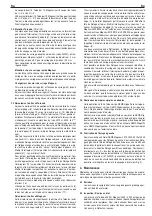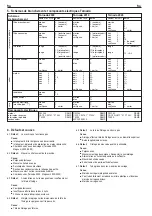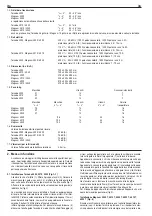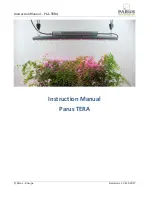
General Safety Rules
WARNING! To reduce the risk of injury, user must read and understand
instruction manual.
WARNING!
Read all instructions. Failure to follow all instructions listed be-
low may result in electric shock, fire and/or serious injury. The term „power
tool“ in all of the warnings listed below refers to your mains operated (cor-
ded) power tool or battery operated (cordless) power tool, also machines
and electric units. Only use the power tool for the purpose for which it was
intended, with the due attention to the general safety and accident preven-
tion regulations.
SAVE THESE INSTRUCTIONS.
A) Work area
a) Keep work area clean and well lit.
Cluttered and dark areas invite ac-
cidents.
b) Do not operate power tools in explosive atmospheres, such as in
the presence of flammable liquids, gases or dust.
Power tools crea-
te sparks which may ignite the dust or fumes.
c) Keep children and bystanders away while operating a power tool.
Distractions can cause you to lose control.
B) Electrical safety
a) Power tool plugs must match the outlet. Never modify the plug in
any way. Do not use any adapter plugs with earthed (grounded) po-
wer tools.
Unmodified plugs and matching outlets will reduce risk of elec-
tric shock. If the power tool comes with an earthed wire, the plug may on-
ly be connected to an earthed receptacle. At work sites, in damp sur-
roundings, in the open or in the case of comparable types of use, only
operate the power tool off the mains using a 30 mA fault current protec-
ted switch (FI breaker).
b) Avoid body contact with earthed or grounded surfaces such as pipes,
radiators, ranges and refrigerators.
There is an increased risk of elec-
tric shock if your body is earthed or grounded.
c) Do not expose power tools to rain or wet conditions.
Water entering
a power tool will increase the risk of electric shock.
d) Do not abuse the cord. Never use the cord for carrying, pulling or
unplugging the power tool. Keep cord away from heat, oil, sharp ed-
ges or moving parts.
Damaged or entangled cords increase the risk of
electric shock.
e) When operating a power tool outdoors, use an extension cord suitable
for outdoor use.
Use of a cord suitable for outdoor use reduces the risk
of electric shock.
C) Personal safety
a) Stay alert, watch what you are doing and use common sense when
operating a power tool. Do not use a power tool while you are tired
or under the influence of drugs, alcohol or medication.
A moment of in-
attention while operating power tools may result in serious personal injury.
b) Use safety equipment. Always wear eye protection.
Safety equipment
such as dust mask, non skid safety shoes, hard hat, or hearing protec-
tion used for appropriate conditions will reduce personal injuries.
c) Avoid accidental starting. Ensure the switch is in the off position be-
fore plugging in.
Carrying power tools with your finger on the switch or
plugging in power tools that have the switch on invites accidents.
d) Remove any adjusting key or wrench before turning the power tool
on.
A wrench or a key left attached to a rotating part of the power tool may
result in personal injury.
e) Do not overreach. Keep proper footing and balance at all times.
This
enables better control of the power tool in unexpected situations.
f) Dress properly. Do not wear loose clothing or jewellery. Keep your
hair, clothing and gloves away from moving parts.
Loose clothes, je-
wellery or long hair can be caught in moving parts.
g) If devices are provided for the connection of dust extraction and col-
lection facilities, ensure these are connected and properly used.
Use
of these devices can reduce dust related hazards.
h) Only allow trained personnel to use the power tool.
Apprentices may
only operate the power tool when they are over 16, when this is neces-
sary for their training and when they are supervised by a trained operative.
D) Power tool use and care
a) Do not force the power tool. Use the correct power tool for your
application.
The correct power tool will do the job better and safer at the
rate for which it was designed.
b) Do not use the power tool if the switch does not turn it on and off.
Any power tool that cannot be controlled with the switch is dangerous and
must be repaired.
c) Disconnect the plug from the power source before making any adjust-
ments, changing accessories, or storing power tools.
Such preven-
tive safety measures reduce the risk of starting the power tool accidentally.
d) Store idle power tools out of the reach of children and do not allow
persons unfamiliar with the power tool or these instructions to ope-
rate the power tool.
Power tools are dangerous in the hands of untrai-
ned users.
e) Maintain power tools. Check for misalignment or binding of moving
parts, breakage of parts and any other condition that may affect the
power tools operation. If damaged, have the power tool repaired by
a qualified expert or by an authorised REMS after-sales service fa-
cility before use.
Many accidents are caused by poorly maintained po-
wer tools.
f) Keep cutting tools sharp and clean.
Properly maintained cutting tools
with sharp cutting edges are less likely to bind and are easier to control.
g) Secure the workpiece.
Use clamps or a vice to hold the workpiece. This
is safer than holding it with your hand, and also it frees both hands to ope-
rate the equipment.
h) Use the power tool, accessories and tool bits etc., in accordance
with these instructions and in the manner intended for the particu-
lar type of power tool, taking into account the working conditions
and the work to be performed.
Use of the power tool for operations dif-
ferent from those intended could result in a hazardous situation. All un-
authorised modifications to the power tool are prohibited for safety reasons.
E) Battery tool use and care
a) Ensure the switch is in the off position before inserting battery pack.
Inserting the battery pack into power tools that have the switch on invites
accidents.
b) Recharge only with the charger specified by the manufacturer.
A
charger that is suitable for one type of battery may create a risk of fire
when used with another battery pack.
c) Use battery tools only with specifically designated battery packs.
Use of any other battery packs may create a risk of injury and fire.
d) When battery pack is not in use, keep it away from other metal objects
like paper clips, coins, keys, nails, screws, or other small metal objects
that can make a connection from one terminal to another.
Shorting
the battery terminals may cause bums or a fire.
e) Under abusive conditions, liquid may be ejected from the battery,
avoid contact. If contact accidentally occurs, flush with water. If li-
eng
eng
1 Wing screw
2 Tool holder
3 Guiding arm front
4 Guiding arm back
5 Pressing lever
6 Clamping ring
7 Handle
8 Die head
9 Length stop
10 Closing and opening lever
11
Clamping lever
12 Adjusting disk
13 Knob/recessed grip
14 Die holder
15 Pipe cutter
16 Deburer
17 Pouring spout
18 Switch
19 Chuck
20 Key for chuck
21 Foot switch
22 Emergency switch
23 Protection switch
24 Guiding
bolt
REMS Tornado 2000 / 2010 / 2020
1 Quick action hammer chuck
2 Guide chuck
3 Switch right-left
4 Foot switch
5 Emergency stop switch
6 Motor overload trip
7 Tool holder
8 Pressing lever
9 Handle
10 Clamping ring with wing nut
11
Wing screw
12 Die head
13 Length stop
14 Closing and opening lever
15 Clamping lever
16 Adjusting disk
17 Die holder
18 Pipe cutter
19 Deburrer
20 Oil trough
21 Chip tray
22 Clamping ring
23 Chuck jaw carrier
24 Chuck jaws
25 Screw plug
REMS Magnum 2000 / 2010 / 2020 / 4000 / 4010 / 4020














































